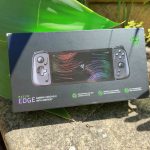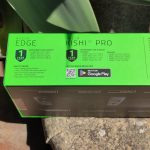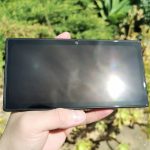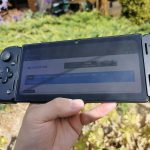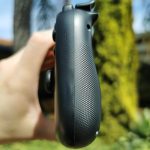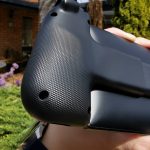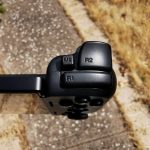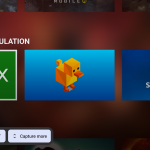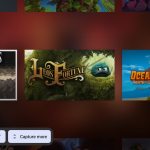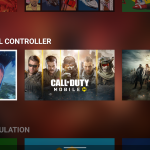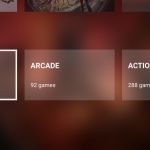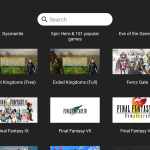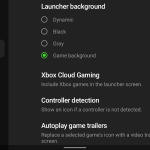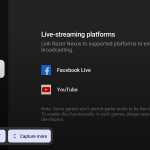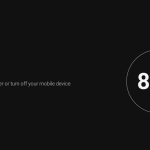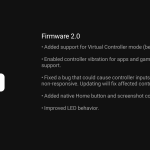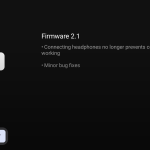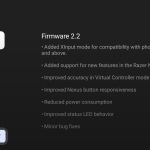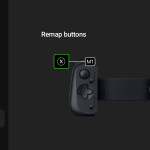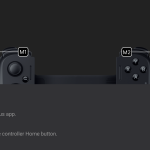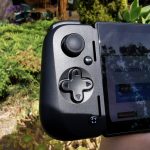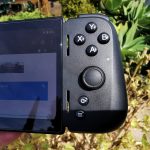A little over a month ago, one of Razer’s marketing partners got in touch with me, asking if I’d be interested in reviewing a certain device. Was there even a second option to consider? I didn’t think twice before happily agreeing. The reason behind my eagerness was that I had been looking forward to getting my hands on the Razer Edge for quite some time, but I never had the opportunity to give it a test drive. I’m truly grateful to Razer for providing me with this chance to review it. Let’s kick things off by talking about the hardware specs, shall we?
With the arrival of the Steam Deck, ROG Ally, and recently, Lenovo Legion Go, the gaming handheld market has truly become a new frontier. Now, let’s unwind and explore the Razer Edge, a product that stands out from the crowd.
The Razer Edge is, at its core, a “tablet” device. It maintains Razer’s signature hardcore e-sports style with its calming black tones, exquisite, rounded edges, and smooth, polished plastic body. Even without the fancy RGB lighting effects, it radiates that strong e-sports vibe.
One of the standout features of the Razer Edge is its impressive 6.8-inch touchscreen. It boasts an AMOLED panel with a sharp 2400 x 1800 resolution and an impressive 144Hz refresh rate, delivering a top-tier visual experience. The colours are exceptionally vibrant and saturated, enhancing the overall visual appeal whether you’re gaming or enjoying audio and video content. It’s incredibly light at only 264 grams without the gaming controller. When used solely as a tablet, the Razer Edge feels like cradling a large, square phone, with the only exception being the absence of an earpiece and rear camera. So, sit back and relax as we dive into the world of this unique gaming gem.
What’s in the box
Hardware and design
At the heart of the Razer Edge beats the Qualcomm Snapdragon G3x Gen 1 processor, a true juggernaut that has been specially optimized for gaming scenarios, resulting in flagship performance that runs smoothly in performance-demanding games such as Genshin Impact, Honkai: Star Rail and Diablo Immortal. You might be wondering, “What’s the deal with this model?” Well, it’s not exactly a household name yet, and that’s because it’s Qualcomm’s new System on a Chip (SoC) crafted specifically for gaming devices. The Razer Edge proudly stands as the lone Android gaming titan to harness the full potential of this platform, all while embracing the cutting-edge Snapdragon Elite Gaming technology and design features.
But here’s where the magic happens. When you peek under the hood, you’ll find that the hardware specs of this powerhouse bear a striking resemblance to the Snapdragon 888+, a name that might ring more bells. However, there’s a twist that sets the G3x Gen 1 apart – a built-in active cooling fan design. This fan doesn’t just keep things cool; it kicks performance up several notches, ensuring that your gaming experience on the Razer Edge is not just good but truly exceptional.
Software
The Razer Edge is powered by an Android system, with a built-in Google Play store for easy download of mobile games, as well as pre-installed cloud streaming platforms such as NVIDIA GeForce Now and Steam Link, which allow gamers to utilize the Razer Kishi V2 Pro grips for the best gaming experience.
The Razer Edge also comes with the Razer Nexus app, which integrates a library of locally installed games and streaming platforms. With Nexus, gamers can set up the Razer HyperSense touch feedback and virtual controller mapping, which allows the grip to be used for touchscreen games. There are hundreds of presets for key mapping of popular games. You can also configure the mapping to your preferences if the preset doesn’t work well for you.
The Razer Edge consistently releases system updates, regularly updating the Nexus app. This reflects Razer’s commitment to delivering the best possible user experience for Edge and Kishi players.
Performance
Embark on a gaming journey with the Razer Edge, which effortlessly navigates two thrilling realms: the immersive universe of cloud gaming and the adrenaline-pumping terrain of local Android games. In the cloud, the hardware gracefully adapts, demanding nothing more than a steadfast, high-speed network to unfold the magic of seamless gameplay. With Wi-Fi 6E support, players find solace in the promise of uninterrupted cloud gaming adventures – a true boon for the devoted.
While its processing prowess might dance a step behind the Qualcomm Snapdragon 8Gen1 Plus, the Razer Edge twirls into the limelight with active cooling choreography, ensuring that the G3x Gen 1 delivers a performance spectacle. Picture this: childhood memories of handheld wonder embodied in the likes of the Game Boy and PlayStation Portable. Now, fast forward to a revelation—engaging the PSP emulator at 4x screen resolution on the Razer Edge stabilizes renowned titles like God of War: Chains of Olympus with enviable ease. A silky-smooth 60 fps dance ensues, and even after 20 minutes of gameplay, the unit’s back merely warms up, refusing to break a sweat.
Yet, the G3x Gen1’s grand performance spectacle finds itself suspended between the Snapdragon 888 and the Snapdragon 8Gen1+, showcasing its prowess in a unique niche. Engage in the epic world of Genshin Impact, and the fan’s enthusiastic applause might demand your attention, especially when the graphics settings are pushed to their limits. A solution presents itself: let the fan serenade your victories while you don the cloak of headphones, reducing the audible impact and ensuring your gaming odyssey remains undisturbed. The Razer Edge invites you to a performance, where every nuance is an invitation to a world where gaming dreams unfold, echoing the symphony of victory and the thrill of conquest.
The Kishi V2 Pro as a wingman
What sets the Razer Edge apart from the crowd is its intriguing ability to shape-shift into a gaming console, all thanks to the bundled Razer Kishi V2 Pro controller. It’s like having a chameleon in your gaming arsenal, ready to adapt to whatever gaming scenario you throw at it.
The well-loved Razer Kishi mobile controller, now upgraded to the V2 Pro version, comes with some nifty additions tailor-made for the Razer Edge. Imagine built-in support for Razer HyperSense haptic feedback technology, delivering that extra touch of immersion. Plus, they’ve thrown in a nifty 3.5mm audio jack for players to plug in their trusty wired headphones. And not to forget, the USB-C charging port in the bottom right corner of the controller is still there, offering that convenient power supply.
Now, the Razer Kishi V2 Pro game controller retains its slick extendable support arm design. All you have to do is slide out one side of the controller and connect it to your Razer Edge tablet via USB-C. No extra pairing fuss – it’s that seamless. And the best part? No need to worry about charging it up; it’s good to go anytime, anywhere. But, remember, it doesn’t have its battery stash, so don’t expect it to double as a power bank for your Razer Edge. The good news is, that you can do a pass-through charging via the Kishi v2 Pro controller while you are gaming. However, when you charge the Razer Edge via the Kishi gaming controller, the input power wattage decreases from 25 watts to 15 watts, which can take a much longer time to charge.
The Kishi V2 offers fantastic compatibility
Just like the previous generation, the Razer Kishi V2 Pro can provide nearly the best compatibility among similar products. The USB-C gaming controllers I have used before, often fall short when used with some non-mainstream phones, such as a Huawei P30 Pro that I still use sometimes. I have tested the Kishi v2 Pro on different phones, including the OnePlus 9 Pro, OPPO Find X2 Pro, Huawei P30 Pro, and Pixel 6a etc, and they all worked perfectly well. That’s why I like Razer controllers so much because it’s truly professional when it comes to gaming.
The classic controller layout
Imagine the Razer Kishi V2 Pro’s button layout as that dependable old buddy who never changes, always sticking to what works. On each side, you’ve got those clickable analog thumbsticks, a cross-pad, YBAX buttons, L1/L2 triggers, R1/R2 shoulder buttons, and the versatile M1/M2 keys. There’s even space for menu and screenshot buttons, not to forget the magic “Open Razer Nexus App” shortcut. It’s like a button buffet, sumptuous and satisfying.
Now, when the gaming showdown begins, the Razer Kishi V2 Pro steps up, quicker than your caffeine fix in the morning. It delivers that Razer-level feedback, as comforting as a snug blanket on a frosty evening. Plus, when you partner it with the Razer Edge, the weight balance is just right – no uneven, “two-light-side” juggling act. It’s a gaming match made in professional hands, with all the buttons and equilibrium you need for an effortless adventure.
Pros and Cons
The Good
- Nexus app
- Active cooling fan (no throttling)
- Impressive sound and vibration
The Bad
- Battery drains quickly with the controller connected
- The fan can be loud
- Difficult to justify the cost when you already have an Android flagship mobile
Final words
The Razer Edge and Kishi v2 Pro bundle comes highly recommended for avid mobile gamers seeking the ultimate gaming experience. However, the close-to $900 price tag may give you pause, making it important to assess whether it’s a justifiable investment based on your usage. If it is, this bundle is well worth the cost, thanks to several features that ensure its longevity.
To start, the Kishi v2 Pro controller operates without a separate battery, drawing power directly from your mobile phone. This means you won’t have to worry about battery degradation over time, ensuring its durability. One of its standout features is its exceptional compatibility. You can manually map the controller’s buttons to any game with touch controls, making it effortless and comfortable to play games that weren’t originally designed for controller use.
Moreover, the controller’s USB Type-C port and 3.5mm jack allow you to charge your phone while gaming and connect wired headphones. In summary, it delivers a superb gaming experience, whether you’re enjoying basic Android games or streaming games through services like GeForce NOW, Xbox GamePass, or Steam Link, all of which it fully supports.
As for the Razer Edge, it’s an impressive gaming device, but its suitability as a Nintendo Switch or Steam Deck replacement or companion depends on your preferences. Like most Android-powered gaming handhelds, the Edge requires some effort to optimize local gaming, though cloud gaming and the Nexus interface help streamline the experience. It also functions effectively as a standalone Android tablet. While it’s pricier than Nintendo Switch models and on par with the base Steam Deck, it offers greater customization options than the former and boasts superior longevity and portability compared to the latter. This makes the Razer Edge an excellent choice for a specific niche of gamers.
Where to get them
The Razer Edge is offered as a bundle with the Kishi V2 Pro Controller for AU$889.95 on Razer’s official website. In regards to its pricing, the Edge is not targeted towards the average consumer; instead, it caters to dedicated mobile platform players who prioritize a superior gaming and control experience. Thanks to its active cooling feature, the Edge effortlessly delivers an outstanding gaming experience. It’s fair to say that the Kishi unquestionably belongs to the top tier of game controllers for mobile platforms, offering the best control experience to date.
Disclosure Statement
Razer has allowed Ausdroid to retain this review device to monitor updates and review accessories.




